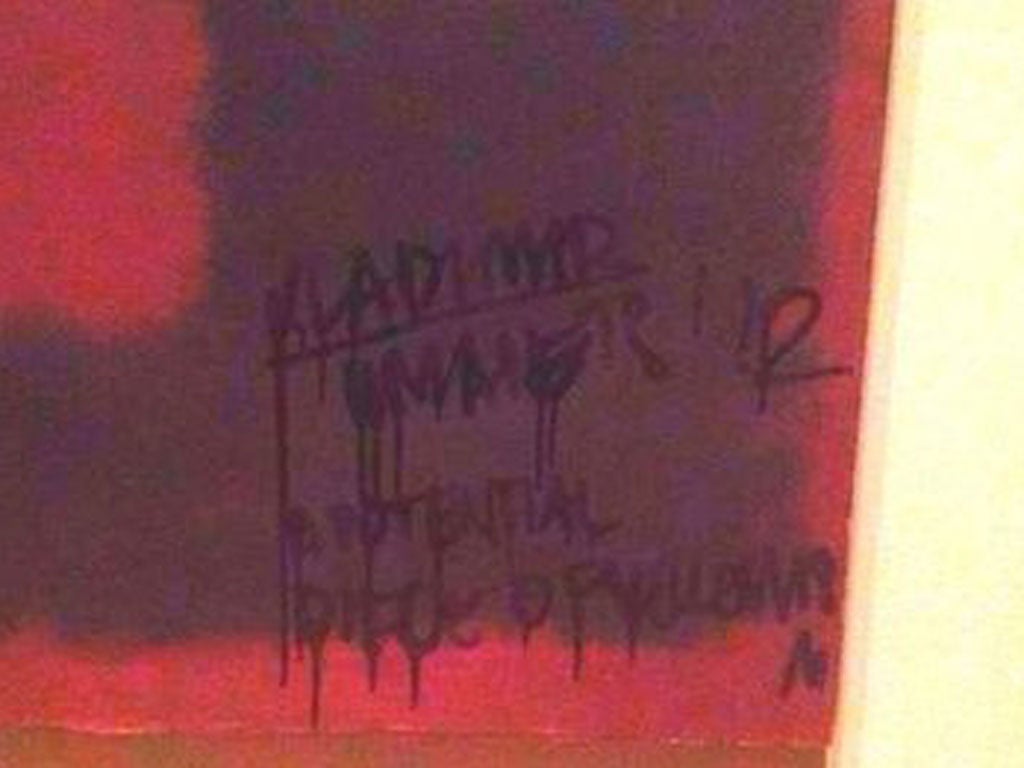Founder of ‘Yellowism’ movement Vladimir Umanets admits defacing valuable Mark Rothko painting at the Tate Modern

Your support helps us to tell the story
From reproductive rights to climate change to Big Tech, The Independent is on the ground when the story is developing. Whether it's investigating the financials of Elon Musk's pro-Trump PAC or producing our latest documentary, 'The A Word', which shines a light on the American women fighting for reproductive rights, we know how important it is to parse out the facts from the messaging.
At such a critical moment in US history, we need reporters on the ground. Your donation allows us to keep sending journalists to speak to both sides of the story.
The Independent is trusted by Americans across the entire political spectrum. And unlike many other quality news outlets, we choose not to lock Americans out of our reporting and analysis with paywalls. We believe quality journalism should be available to everyone, paid for by those who can afford it.
Your support makes all the difference.A man has claimed responsibility for defacing a valuable mural by Mark Rothko at the Tate Modern this weekend.
Vladimir Umanets, the Russian-born founder of the Yellowism movement admitted daubing the words ‘Vladimir Umanets, A Potential Piece of Yellowism’ in black ink or paint on the bottom of one of Rothko’s Seagram paintings.
Scotland Yard immediately launched an investigation into the incident, which occurred at the Tate Modern art gallery at around 3.25pm yesterday. The force said it was looking for a white male in his late 20s.
Today Mr Umanets said he had written on the painting, but insisted his aim was not to destroy or deface it.
"Some people think I'm crazy or a vandal, but my intention was not to destroy or decrease the value, or to go crazy. I am not a vandal," he said.
"It's good people are shocking about what happened, no-one is realising what actually happened, everyone is just posting that the piece has been damaged or destroyed or defaced.
"But I believe that after a few years they will start looking for it from the right angle. So that's why I did it."
Mr Umanets, who would not reveal his age or where he lives, said he knows he is likely to be arrested, but added: "I believe that from everything bad there's always a good outcome so I'm prepared for that but obviously I don't want to spend a few months, even a few weeks, in jail. But I do strongly believe in what I am doing, I have dedicated my life to this."
He said he did not plan exactly which painting he would write on, but thinks he found "the perfect choice", and said he feels he may have increased the value.
"To be honest, I do believe I increased the value, it seems probably ridiculous for someone but I do believe in this, I didn't decrease the value, I didn't destroy this picture, I put something new."
The Tate Modern said it does not have a price for the defaced piece, but paintings by the Russian-born artist often fetch tens of millions of pounds.
A spokeswoman said: "There was an incident at Tate Modern in which a visitor defaced one of Rothko's Seagram murals by applying a small area of black paint with a brush to the painting.
Eyewitness Tim Wright (WrightTG) posted on Twitter: "This guy calmly walked up, took out a marker pen and tagged it. Surreal.
"We gave a description to the gallery. Very bizarre, he sat there for a while then just went for it and made a quick exit."
A picture he uploaded to the social networking website showed five or six words scrawled on the bottom-right corner of the piece, with black streaks of paint running down from the daubed writing.
Earlier this year, Rothko's Orange, Red, Yellow was sold for £53.8 million - the highest price ever paid for a piece of post-war art at auction.
The 1961 painting went under the hammer at Christie's in New York.
Mr Umanets, who studied art, is one of the founders of "Yellowism", which he describes as "neither art, nor anti-art".
"Yellowism is not art, and Yellowism isn't anti-art. It's an element of contemporary visual culture. It's not an artistic movement.
"It's not art, it's not reality, it's just Yellowism. It can't be presented in a gallery of art, it can be presented only in a Yellowistic chambers.
"The main difference between Yellowism and art is that in art you have got freedom of interpretation, in Yellowism you don't have freedom of interpretation, everything is about Yellowism, that's it.
"I am a Yellowist. I believe what I am doing and I want people to start talking about this. It was like a platform.
"I don't need to be famous, I don't want money, I don't want fame, I'm not seeking seeking attention.
Join our commenting forum
Join thought-provoking conversations, follow other Independent readers and see their replies
Comments